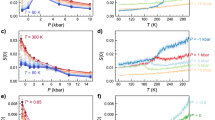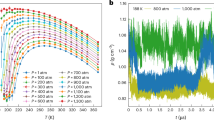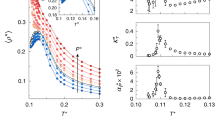Abstract
Non-crystalline solid forms of water prepared by the usual two methods of vapour-deposition on a substrate1,2 and by compression of hexagonal ice in a piston cylinder apparatus at 77 K (refs 3,4) do not seem to undergo a glass–liquid transition on heating2,5–7. Neither of these two, or possibly three, non-crystalline forms seem to be interconvertible by a single thermodynamic path involving only temperature or pressure. Also, their molecular structures are thermodynamically discontinuous8, with the structure of bulk water above 273 K and of emulsified water in the supercooled state near 230 K (see also refs 2 and 9). It has been difficult, therefore, to resolve whether or not water supercools to a glassy state in a thermodynamically reversible manner. We now report the results of a calorimetric study of the glassy state of water obtained by rapid cooling or by hyperquenching, demonstrate the reversibility of its glass–liquid transition in the temperature range 113–148 K, and consider the implication to our understanding of its other non-crystalline solid forms.
This is a preview of subscription content, access via your institution
Access options
Subscribe to this journal
Receive 51 print issues and online access
$199.00 per year
only $3.90 per issue
Buy this article
- Purchase on SpringerLink
- Instant access to full article PDF
Prices may be subject to local taxes which are calculated during checkout
Similar content being viewed by others
References
1. Burton, E. F. & Oliver, W. F. Proc. R. Soc. A153, 166 (1935). 2. Sceats, M. G. & Rice, S. A. in Water-A Comprehensive Treatise (ed. Franks, F.) Ch. 2 (Plenum, New York, 1982). 3. Mishima, O. Calvert, L. D. & Whalley, E. Nature 310, 393–395 (1984); 314, 76–78 (1985). 4. Johari, G. P. & Jones, S. J. Phil. Mag. 54B, 311–315 (1986). 5. MacFarlane, D. R. & Angell, C. A. 7. phys. Chem. 88, 759–762 (1984). 6. Handa, Y. P., Mishima, O. & Whalley, E. J. chem. Phys. 84, 2766–2770 (1986). 7. Mayer, E. & Pletzer, R. J. chem. Phys. 80, 2939–2952 (1984). 8. Johari, G. P. Phil. Mag. 35, 1077–1090 (1977). 9. Angell, C. A. in Water-A Comprehensive Treatise (ed. Franks, F.) Ch. 1 (Plenum, New York, 1982). 10. Mayer, E. J. appl. Phys. 58, 663–667 (1985); /. phys. Chem. 89, 3474–3477 (1985). 11. Mayer, E. J. phys. Chem. 90, 4455–4461 (1986). 12. Hallbrucker, A. & Mayer, E. J. phys. Chem. 91, 503–505 (1987). 13. Wong, J. & Angell, C. A. in Glass: Structure by Spectroscopy Ch. 1 (Dekker, New York, 1976). 14. Johari, G. P. & Goldstein, M. J. chem. Phys. 53, 4245–4252 (1971). 15. Stephens, R. B. /. Non-Cryst. Solids 20, 75–81 (1976). 16. Angell, C. A., Shuppert, J. & Tucker, J. C. /. phys. Chem. 77, 3092–3097 (1973). 17. Maddox, J. Nature 326, 823 (1987). 18. Speedy, R. J. / phys. Chem. 86, 982–991 (1982).
Author information
Authors and Affiliations
Rights and permissions
About this article
Cite this article
Johari, G., Hallbrucker, A. & Mayer, E. The glass–liquid transition of hyperquenched water. Nature 330, 552–553 (1987). https://doi.org/10.1038/330552a0
Received:
Accepted:
Issue date:
DOI: https://doi.org/10.1038/330552a0
This article is cited by
-
Effect of counterions on the water sorption and glass transition properties of maltobionate salts
Journal of Thermal Analysis and Calorimetry (2024)
-
Divergent Deborah number-dependent transition from homogeneity to heterogeneity
Nature Communications (2023)
-
Glass transition behavior of carnosine and its impact as a protectant on freeze-dried lactic acid bacteria
Food Biophysics (2022)
-
Effect of Glass Transition Temperature Range on the Caking Behavior of Freeze-dried Carbohydrate Blend Powders
Food Engineering Reviews (2021)
-
Water sorption, glass transition, and freeze-concentrated glass-like transition properties of calcium maltobionate–maltose mixtures
Journal of Thermal Analysis and Calorimetry (2019)



